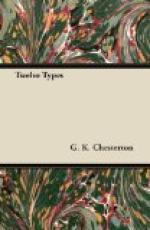TOLSTOY AND THE CULT OF SIMPLICITY
The whole world is certainly heading for a great simplicity, not deliberately, but rather inevitably. It is not a mere fashion of false innocence, like that of the French aristocrats before the Revolution, who built an altar to Pan, and who taxed the peasantry for the enormous expenditure which is needed in order to live the simple life of peasants. The simplicity towards which the world is driving is the necessary outcome of all our systems and speculations and of our deep and continuous contemplation of things. For the universe is like everything in it; we have to look at it repeatedly and habitually before we see it. It is only when we have seen it for the hundredth time that we see it for the first time. The more consistently things are contemplated, the more they tend to unify themselves and therefore to simplify themselves. The simplification of anything is always sensational. Thus monotheism is the most sensational of things: it is as if we gazed long at a design full of disconnected objects, and, suddenly, with a stunning thrill, they came together into a huge and staring face.
Few people will dispute that all the typical movements of our time are upon this road towards simplification. Each system seeks to be more fundamental than the other; each seeks, in the literal sense, to undermine the other. In art, for example, the old conception of man, classic as the Apollo Belvedere, has first been attacked by the realist, who asserts that man, as a fact of natural history, is a creature with colourless hair and a freckled face. Then comes the Impressionist, going yet deeper, who asserts that to his physical eye, which alone is certain, man is a creature with purple hair and a grey face. Then comes the Symbolist, and says that to his soul, which alone is certain, man is a creature with green hair and a blue face. And all the great writers of our time represent in one form or another this attempt to re-establish communication with the elemental, or, as it is sometimes more roughly and fallaciously expressed, to return to nature. Some think that the return to nature consists in drinking no wine; some think that it consists in drinking a great deal more than is good for them. Some think that the return to nature is achieved by beating swords into ploughshares; some think it is achieved by turning ploughshares into very ineffectual British War Office bayonets. It is natural, according to the Jingo, for a man to kill other people with gunpowder and himself with gin. It is natural, according to the humanitarian revolutionist, to kill other people with dynamite and himself with vegetarianism. It would be too obviously Philistine a sentiment, perhaps, to suggest that the claim of either of these persons to be obeying the voice of nature is interesting when we consider that they require huge volumes of paradoxical argument to persuade themselves or anyone else of the truth of their conclusions. But the giants of our time are undoubtedly alike in that they approach by very different roads this conception of the return to simplicity. Ibsen returns to nature by the angular exterior of fact, Maeterlinck by the eternal tendencies of fable. Whitman returns to nature by seeing how much he can accept, Tolstoy by seeing how much he can reject.




